In Chapter four of our latest book Student Voice: From Invisible to Invaluable (2018 Rowman & Littlefield), Nick Polyak, PJ Caposey, and I start the chapter with the following quote from Dorothy Day: “The greatest challenge of the day is: how to bring about a revolution of the heart, a revolution which has to start with each one of us.” (page 55). In chapter four we also feature the voice of high school student Kyla Guru.
In this blog post, I am sharing an article published today that shares excerpts of 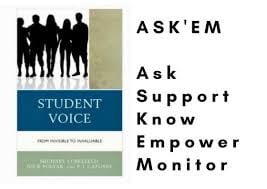 the conclusion of our book and highlights the special end of chapter feature we created: ASK’EM. It’s an acronym for what we suggest throughout the book about how leaders can incorporate student voice … just “ask’em”. The letters represent Ask, Support, Know, Empower, & Monitor, and throughout the book we share examples, suggestions, calls to action, etc. that leaders (and readers) can implement to incorporate student voice in their schools, organizations, communities, and settings! At the end of our book we have a special offer from human capital management firm HUMANeX Ventures for every reader to take a free Sensory Preference Inventory™.
the conclusion of our book and highlights the special end of chapter feature we created: ASK’EM. It’s an acronym for what we suggest throughout the book about how leaders can incorporate student voice … just “ask’em”. The letters represent Ask, Support, Know, Empower, & Monitor, and throughout the book we share examples, suggestions, calls to action, etc. that leaders (and readers) can implement to incorporate student voice in their schools, organizations, communities, and settings! At the end of our book we have a special offer from human capital management firm HUMANeX Ventures for every reader to take a free Sensory Preference Inventory™.
From the book: “Continued learning and development starts at the foundation – first understanding HOW you learn best. Having a clear understanding if you are a VISUAL, AUDITORY, or KINESTHETIC learner can greatly impact the way in which you learn and grow in your life and career.”
In future blog posts I’ll share local efforts at gaining Student Voice through the Student Engagement Survey with HUMANeX Ventures (a survey being administered to all students in our district from grades 3-8 this month). For now … here is the article just published (as always, comments are encouraged and welcomed):
DisruptED TV Magazine
Student Voice: From Invisible to Invaluable
By Michael Lubelfeld, Nick Polyak & Phillip J. ‘PJ’ Caposey
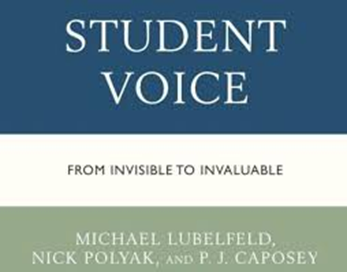
As educators we are engaged in listening every day. As superintendents we’re also engaged in leading every day. As leaders we have tested theories and approaches to systems change for many years in suburban and rural PK-12 school systems. Recently we started writing as a way to reflect, share messages of success, and in an effort to inspire others. One of our latest projects Student Voice: From Invisible to Invaluable (2018 Rowman & Littlefield) underscores the value we place on student voice in the overhaul and transformation for education in our nation. In this article we’re sharing excerpts from the preface of the book that include a call to action.

Student Voice: From Invisible to Invaluable is about why today’s leaders need to connect with students and how to accomplish true success by giving students a voice in their own education. The premise of this book is that student voice is often, for some inconceivable reason, invisible.

The failure to systematically include students and listen to their viewpoints is a contributing factor which explains why schools have changed little since the 19th Century. This book will explore many topics ranging from digital citizenship to teacher evaluation, and we sincerely believe that by leveraging the voice of students as collaborative leaders, true school and educational transformation can and will occur.
The book is based around two central questions:
● Why should today’s school leaders engage student voice from a leadership perspective as collaborators in leading?
● How can today’s school leaders engage student voice from a leadership perspective as collaborators in leading?

Core beliefs that drive this book are largely based on research. These beliefs include that the single most impactful person in a student’s learning journey is the teacher. The second most impactful is the principal (Marzano & Waters 2005). If the teacher is a manager and the principal is a leader, congruence in the approaches of engaging the student in his own learning must exist. Additionally, confidence is necessary to amplify student voice in our schools.
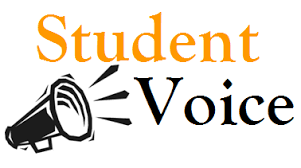
We submit that taking student voice from invisible to invaluable reflects the choices made by confident leaders. Leaders in the classroom (teachers) and leaders in the office (principals) and leaders in the central office (superintendents) must exist at all levels to truly listen to student voice and for school evolution and even transformation to be possible. Throughout this book, we will continually work to convince the reader of why this paradigm shift leading to an increase in student voice is necessary and give tips and techniques on how to get the work done.

Our leadership journeys allow us to test theories of leadership and put into practice beliefs, hypotheses, thoughts, and actions. While we lead with other adults and members of the typical school community: teachers, board members, administrators, and parents, we have engaged students in leadership as well. We share our successful leadership experiences and examples of making student voices invaluable in actual leadership and governance.

This transformation is truly a win-win for students and leaders. Educators must simply do two things to begin the paradigm shift necessary to take this forward. The first is easy — believe in the brilliance of your students. The second is hard — relinquish some element of control. This book will help walk you through both of these steps while focusing on precise areas of potential change within your classroom, school, or district.
EDUCATIONAL CONTEXT — Why the book is necessary
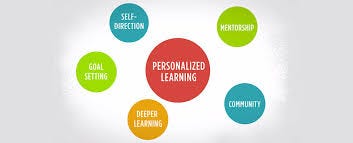
Around the nation many leaders are implementing various forms of personalized learning. The synergy between student learning and growth and teacher direction and knowledge grows exponentially when student voice is real, true, and authentic. Long gone are the days where compliance rules the priorities of teachers and schools. We will examine personalized learning and how student voice can be amplified through personalized learning environments.

Our vision is for student/learner centered systems that we’re compelled to create. As Mike and Nick wrote about in The Unlearning Leader: Leading for Tomorrow’s Schools Today (2017 Rowman & Littlefield) we all must unlearn so that we can learn and relearn — change is not an optional process.

Today’s leaders, teachers, students, pretty much all constituent stakeholder groups, must embody the 4Cs: communication, collaboration, critical thinking, and creativity. Teaching students what it means to “be at the table” and teaching students how to think “outside of the box” opens up pathways never before seen or applied in modern school systems.

These pathways can be replicated and refined with student leadership experiences in “real life” through their schooling experiences. Student voice does not “just happen;” the success of this fundamental shift in how we ‘do school’ is dependent upon shared vision, deliberate engagement, and by teaching students how to be a part of the process. We share examples of how and why the future belongs to the students and the present-day leaders can do much to set them up for success.

With this type of engaged and partner leadership we will allow future generations to bear witness to transformed systems of schooling and society. Long gone are the days of “sage on the stage” — in order to support the “guide on the side.” Leaders can engage students and establish new norms so their input becomes invaluable. This is a call to action book for all people interested in transforming education and to improving the world.
The learning purposes and unique features of this book include:
● Establish, propose, and reinforce the “How” and the “Why” for including student voice in leadership decision making
● Provide leaders with actionable case studies and examples from the field for implementation
● Model and share new ways of incorporating authentic student voice
● Reflection questions that will generate thought and conversation around each chapter
● End of chapter feature ASK’EM, an actionable acronym, at the end of each chapter to both reinforce chapter concepts and examples as well as a call to action: Ask, Support, Know, Empower, Monitor
● Stop-Think-Act prompts, questions, problems of practice
● Commentaries and essays from students and educational leaders throughout the book. This provides additional voices on the topics on progressing with student voice from invisible to invaluable.
About the Authors
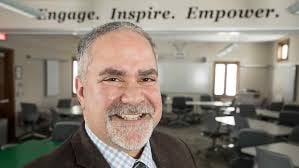
Michael Lubelfeld, Ed.D.-Mike currently serves as the superintendent of schools in North Shore School District 112 in Highland Park, IL. His blog is at https://mikelubelfeld.edublogs.org/ He can be found on Twitter at @mikelubelfeld and he is the co-moderator of #suptchat — the superintendent educational chat on Twitter. He and Nick Polyak authored the 2017 Rowman & Littlefield book The Unlearning Leader: Leading for Tomorrow’s Schools Today. Mike has been married to his wife Stephanie for the past 15 years and they have two children.
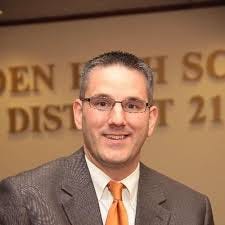
Nick Polyak, Ed.D.-Nick is the superintendent of Leyden Community High School District 212 in Franklin Park, IL. He can be found on Twitter at @npolyak and he is the co-moderator of #suptchat — the superintendent educational chat on Twitter. Nick has been married to his wife Kate for the past 17 years and they have four children.

Phillip J. “PJ” Caposey, Ed.D.-PJ is the author of three books and is a sought after speaker and consultant specializing in school culture, principal coaching, effective evaluation practices, and student-centered instruction. PJ currently serves as the Superintendent of Schools for Meridian CUSD 223 in Northwest Illinois and is married to his wife Jacquie and has four children. PJ can be reached via twitter @MCUSDSupe.

Leave a Reply